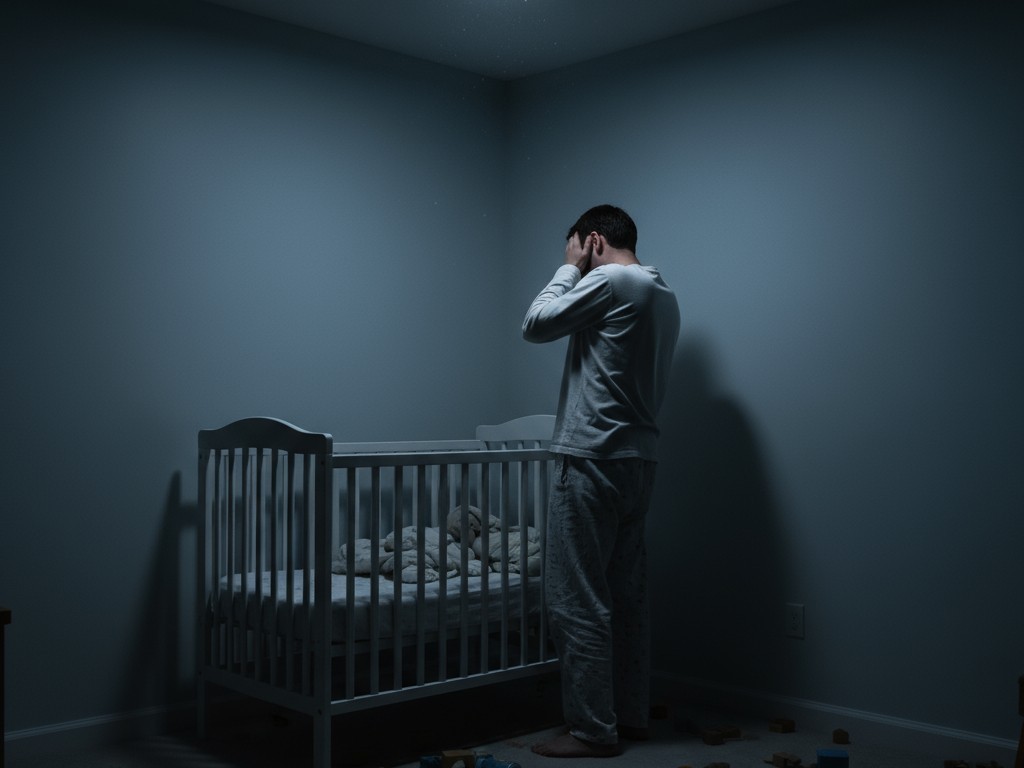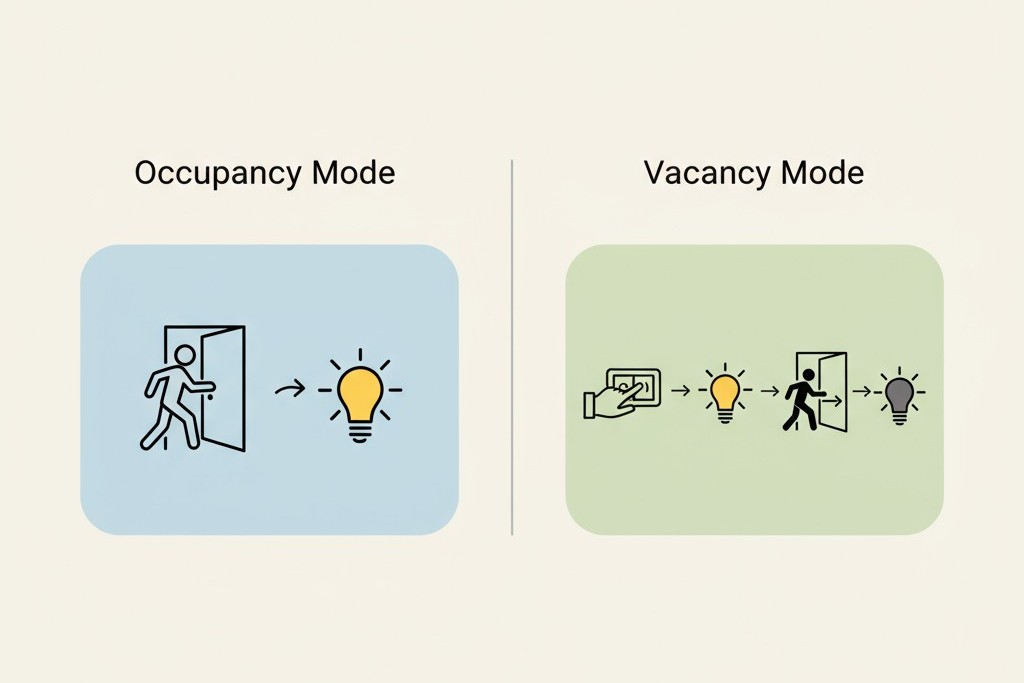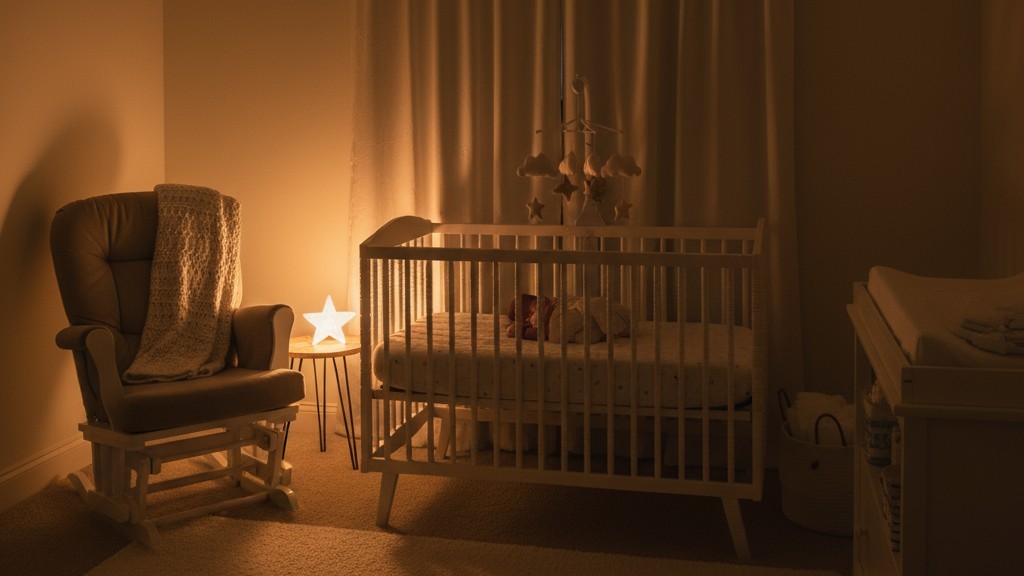Two in the morning. A toddler cries out, and a parent rises, half-asleep, to enter the nursery. Instinct takes over: flip the switch to see, to navigate, to assess the need. But the overhead light that floods the room also constricts the child’s pupils and replaces the parent’s grogginess with a jarring alertness. The light meant to help has just sabotaged the rest of the night.

Bright light exposure during these hours triggers a cascade of physiological responses that actively dismantle the conditions for sleep. For toddlers with developing circadian rhythms and parents with already fragmented rest, the choice of nursery lighting is a high-stakes decision. Yet most conventional solutions, from overhead fixtures to voice-activated smart bulbs and app-controlled scenes, are fundamentally misaligned with the realities of midnight caregiving.
Vacancy mode with low-lux enablement offers a different architecture. It’s a sensor-driven approach that inverts the typical motion-activated model, granting manual control over illumination while automating the shutdown. It delivers just enough light for safety and visibility without triggering the biological mechanisms that reset sleep cycles. Most importantly, it operates with the simplicity a sleep-deprived mind requires, eliminating the latency, cognitive steps, and distractions of voice assistants or smartphones. This isn’t about adding complexity to the nursery; it’s about removing it.
The Hidden Cost of Bright Nursery Lights at 2 A.M.
It’s an automatic behavior: enter a dark nursery, reach for the wall switch, and flood the room with light. The immediate task, whether checking a diaper or offering comfort, seems safer. But the light itself has already triggered a biological process that will outlast the visit by hours.
Human circadian rhythms are governed by the suprachiasmatic nucleus in the hypothalamus, which synchronizes the body’s internal clock to external light cues. When photoreceptors in the retina detect bright light, especially in the blue spectrum, they signal the brain to suppress melatonin, the hormone that facilitates sleep. In daylight, this is desirable. At two in the morning, it is physiologically counterproductive. A single exposure to bright light can shift the circadian phase, making it harder to fall back asleep and reducing the quality of any sleep that follows. For a toddler, this can mean being fully awake for an hour or more. For the parent, it can mean lying awake, unable to recapture lost rest.
The parent who turns on the overhead light is equally vulnerable. The resulting alertness is not a benefit; it’s a liability. The cognitive fog that allows a person to complete a quick task and return to bed is replaced by sharp wakefulness. Over weeks and months, the cumulative sleep debt from these midnight exposures contributes to the chronic exhaustion of early parenthood.
There is also the risk of a startle response. A toddler in a light sleep state may be jolted into full alertness by the sudden brightness. The transition from dark to full illumination is abrupt, and the child’s nervous system reacts. What could have been a brief, self-soothing moment becomes a prolonged period of distress. The parent, intending to help, has inadvertently extended the disruption.
Why Conventional Lighting Solutions Fail the Midnight Test
Parents understand the problem, but the solutions on the market are not designed for the specific constraints of a midnight nursery visit. Most fall into one of three categories, and each undermines the core goals of safety, simplicity, and sleep preservation.
Voice-activated systems: Smart bulbs promise hands-free control, but in practice, they introduce new problems. There is latency—the two-to-three-second delay between command and execution is disorienting in the dark. There is cognitive load—remembering the exact phrase and speaking clearly without waking the child adds stress. And there is the failure mode: a misunderstood command or a slow network leaves a parent in the dark, now more awake from frustration.
App-based scenes: Smartphone controls allow for customized dim, warm scenes. But this requires finding the phone, unlocking it, opening an app, and navigating to the correct setting. The phone screen itself is a source of blue light, and the interface—with its notifications and temptations to check the time—pulls the parent further into wakefulness. The phone, which should stay on the nightstand, becomes a required and distracting tool.
Maybe You Are Interested In
Always-on night lights: The low-tech alternative is a constant, dim plug-in light. This avoids sudden brightness but creates other issues. If it’s too dim, it’s useless for tasks, forcing a parent to turn on another light anyway. If it’s bright enough to be functional, its constant glow can interfere with melatonin production over time. Static night lights are also not adaptable; they are always on, providing light when it isn’t needed.
The gap in these approaches is the same. They either demand too much from a sleep-deprived parent or fail to provide the right light at the right time. The ideal system would offer manual control on entry, automatic shutdown on exit, and carefully calibrated light.
How Vacancy Mode Solves the Core Problem
This is precisely the logic behind vacancy mode, a sensor-driven approach that is fundamentally different from the more common occupancy mode.
Looking For Motion-Activated Energy-Saving Solutions?
Contact us for complete PIR motion sensors, motion-activated energy-saving products, motion sensor switches, and Occupancy/Vacancy commercial solutions.

Occupancy vs. Vacancy: In occupancy mode, the sensor automatically activates the light when it detects motion and turns it off after a period of inactivity. It’s designed for convenience in high-traffic areas. In vacancy mode, the logic is inverted. The user must manually turn the light on with a switch. Once activated, the sensor takes over, monitoring for motion and turning the light off automatically when the room is empty. The user deliberately triggers the light; the sensor handles the shutdown.
This simple inversion is a fundamental reorientation of control that maps perfectly to a parent’s needs.
The Manual-On Advantage: When a parent flips the switch in vacancy mode, the choice is deliberate. There is no surprise illumination. The parent initiates the light, eliminating the startle response for both parent and child. If the toddler is awake, the parent can even offer a verbal cue before turning on the light, further softening the transition from darkness. Control remains with the human, where it belongs in a sensitive context.
The Auto-Off Convenience: Once the task is underway, the parent doesn’t need to think about turning the light off. Their movements keep the light active. When they leave the room, the sensor detects their absence and starts a countdown. After a preset delay, the light turns off automatically. Back in bed, the parent doesn’t have to wonder if they left the light on. Forgetfulness, a staple of sleep deprivation, is no longer a problem.
The result is a lighting system that provides the right amount of automation: just enough to remove friction from the exit without removing agency from the entry. The parent retains control over the most critical moment—the initial activation—and delegates the less critical task of shutdown.
The Role of Low-Lux Activation in Preserving Night Calm

But is dim light enough? Can a parent see well enough to be safe without disrupting sleep? The answer lies in how our vision adapts and how sensor technology can be calibrated to support it.
The human retina contains rods and cones. Cones handle color and detail in bright light, while highly sensitive rods are used for vision in dim conditions. When you enter a dark room, your eyes undergo dark adaptation, and within minutes the rods become sensitive enough to see by very low light. This is scotopic vision. A light source providing only 10 to 50 lux, about the brightness of a candle, is more than adequate for navigation and tasks once the eyes have adjusted. Crucially, this level of illumination does not suppress melatonin to the same degree as bright light. Studies show a dose-response relationship: brighter light causes greater disruption. Keeping the light in the scotopic range provides visibility while minimizing the physiological impact.
The challenge is that many motion sensors are designed to ignore low-light conditions. Their photocells prevent activation during the day, but the threshold is often too high for this use case. A sensor with low-lux enablement solves this. It’s a feature that allows the sensor to operate even when a small amount of ambient light is present. This permits a parent to pair the sensor with a dimmable light set to a very low output. The photocell won’t block activation, the parent sees what they need to see, and the toddler’s sleep is minimally affected.
Configuring Delays and Sensitivity for Nursery Use
The effectiveness of vacancy mode depends on tuning the sensor’s delay and sensitivity settings.
The delay setting determines how long the sensor waits after detecting no motion before turning off the light. Too short, and the light may switch off mid-task while a parent is soothing a child. Too long, and it wastes energy and provides unnecessary light exposure. For a nursery, a delay of 60 to 120 seconds is ideal. This accommodates most nighttime tasks, like a diaper change or a brief soothing session, providing a buffer without extending light exposure unnecessarily.
Sensitivity and placement also play a role. To avoid false triggers from a toddler’s small movements in the crib, the sensor should be positioned to monitor the entry and main activity zones, like the path from the door to the changing table, but should be angled away from the crib itself. Setting the sensitivity to a moderate level ensures it detects a person’s presence without reacting to minor air currents or a baby kicking a blanket.
The Simplicity Advantage in Sleep-Deprived Moments
At two in the morning, cognitive resources are depleted. Decision-making is slow, and memory is unreliable. Any system designed for this reality must be ruthlessly simple.
Get Inspired by Rayzeek Motion Sensor Portfolios.
Doesn't find what you want? Don't worry. There are always alternate ways to solve your problems. Maybe one of our portfolios can help.
Vacancy mode reduces the interaction to a single, instinctual action on entry and zero actions on exit. Flip the switch, complete the task, and leave. The sensor handles the rest. There are no voice commands to remember, no phone apps to navigate, and no second switch to flip. The cognitive load is minimized, and the potential for error is nearly eliminated. The parent can operate on autopilot—often the only mode available.
Voice assistants and app-controlled scenes fail this test because they introduce complexity and distraction when simplicity is most needed. Vacancy mode succeeds because it aligns with a parent’s natural behavior and then automates the trivial task of shutdown. It respects the limits of human cognition under duress.
For parents navigating the exhausting early years, nursery lighting shouldn’t be another source of friction. It should be a tool that fades into the background, working quietly and predictably to remove one small but persistent burden. Vacancy mode, configured correctly, is that tool. While it won’t solve every problem of sleep deprivation, it removes a specific, repeated obstacle to a calmer night.



























